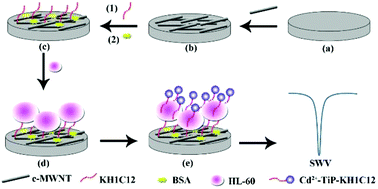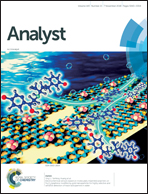An ultrasensitive electrochemical cytosensor for highly specific detection of HL-60 cancer cells based on metal ion functionalized titanium phosphate nanospheres†
Abstract
Facile and sensitive detection methods of cancer cells in the early stage are beneficial for monitoring cancers and treating patients in time to reduce the death rate. In this work, an ultrasensitive cytosensor was constructed using aptamers as cell capturers and metal ion-exchanged titanium phosphate nanospheres as electrochemical probes. KH1C12 can specifically recognize HL-60 cells and distinguish them from other cell lines, K562 and CCRF-CEM, to obtain high selectivity. Cadmium ion functionalized titanium phosphate nanospheres show large quantities of electroactive cadmium ion output and a highly sensitive electrochemical signal. This proposed cytosensor showed a wide dynamic linear range from 102 cells per mL to 107 cells per mL with a low detection limit of 35 cells per mL, providing a new, simple and ultrasensitive platform for cancer diagnosis in biomedical and clinical research.



 Please wait while we load your content...
Please wait while we load your content...